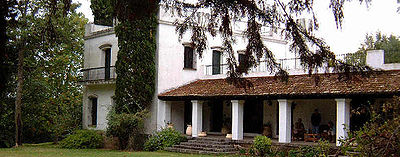Estancia Parada Arteaga
Parada Arteaga is an estancia (country estate / cattle farm) in the Uruguayan Department of Florida with a mansion and farm building , the Casco, built in the (neo) colonial Spanish style in the 1920s. The name "Parada" (stop) indicates that the estate has its own small train station (for loading cattle) on the Montevideo – Illescas railway line. "Arteaga" was the name of the owner family in the middle of the 20th century. The estancia is now a (eucalyptus) forestry operation of around 3,000 hectares in size, owned by the Uruguayan University Employees Pension Fund. Herrenhaus / Casco are currently not in use (2010) and are not open to the public.
history
Parada Arteaga was founded in the first half of the 19th century by the Anglo-Uruguayan Estanciero Juan Jackson (after the lands were already loosely under the rule of the Jesuits in the mid-18th century) and was an important sheep-breeding and breeding company for the next 150 years Wool production plant. The name "Estancia del Cerro" was used for the longest time.
The estancia saw fighting at the time of the " Revolución de las lanzas " 1870-72, during which the troops of both parties to the conflict lived on the land, namely on livestock.
The estate was passed on from generation to generation, often along the lines of women, at the beginning of the 20th century in the possession of the Heber family, then the de Arteaga family. Even today, the large shear house with its 24 disused shearing machines tells of the immense number of sheep that left their wool here and often started their last journey as live cattle from here, first by train and then by ship to the Middle East. In the years 2003-2006 the Casco was run as a hotel.
Web links
Coordinates: 33 ° 44 ′ 22 " S , 55 ° 31 ′ 47" W.
Individual evidence
- ↑ Javier Irureta Goyena Gomensoro, Antiguas estancias del Uruguay Goyena Gomensoro Verlag 1996.

